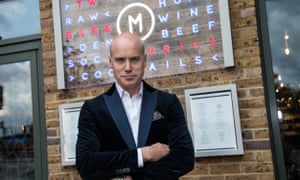Venues in crisis: ‘We couldn’t survive if we opened 10 nights a week’
Pubs, clubs, hotels and restaurants are facing an uncertain future. Social distancing requirements mean there is little chance of returning to anything like normal trade and profits. They now face having to pay towards the government’s furlough scheme when some will not even be able to open their doors. We spoke to enterprises ranging from a Glasgow nightclub to an upmarket London restaurant chain to ask how – or if – they can get back to work.
Mike Grieve
Owner, Sub Club, Glasgow
“I’m right in the eye of the storm at the moment,” says Grieve. His club has been at the forefront of Scotland’s electronic dance scene since the 80s, but is battling for survival after being denied access to the furlough scheme on a technicality.
The club, which has been shut since mid-March and has little prospect of reopening for months to come, has paid out thousands in wages to its 33 staff but may not be able to claim that back.
“It’s really hard at the moment, we are really on our knees,” he says.
Rent payments are on hold and the club has got a business rates holiday under the government-backed scheme, but other government initiatives have proved inaccessible, as Grieve has found it difficult navigating their complexities.
Getting back to business is even more uncertain. The club can hold just over 400 people and Grieve says it needs to operate at near capacity to pay the bills: “We operate on fairly tight margins.”
Under physical distancing rules, which require 2 metres between dancers, Grieve reckons he could fit 100 people in the venue – and there would be questions about how they would be able to get in to the basement premises, queue up, or be served at the bar.
He reckons businesses like his would have no chance of contributing to the furlough scheme: “I don’t think there is any possibility of paying 20% of people’s salaries when we literally have no income. They will have to make exceptions for businesses that are unable to trade.”
He is confident Glasgow’s dance music fans will continue to support the venue whatever happens, but doesn’t expect to reopen until the need for physical distancing ends.
“We couldn’t survive even if we opened 10 nights a week. A hundred people would never cover the additional staff costs or spend on personal protective equipment. In my view we can’t reopen until we can operate at full capacity.
“The very nature of what we do is about people being up close and personal. It’s about shared emotion and euphoria – that’s the nature of the electronic music scene.”
Martin Williams
Chief executive, Gaucho and M restaurant chains

Gaucho and M restaurants furloughed 850 of its 880 staff when the group closed its 16 outlets in March and since then has only been operating an online wine store.
Williams has been working on plans for reopening – if allowed – in July. He says doing so with two-metre distancing will be tough. Capacity in the restaurants will plummet, bars will remain closed and it’s not clear how much demand there will be. He says: “People have got so used to antisocial ways of working and living they’re going to take a bit of time to get back to ‘new normal’ habits.”
Williams believes he’ll see less competition when he does reopen because many restaurants are likely to collapse when rents are due at the end of June. “Any problems a restaurant or brand had will be amplified,” he says. “It will be extreme.”
He reckons most restaurants did not pay quarterly rents due in March and could face a cash crunch next month. “There could be a lot of winding-up orders without government help,” he says.
In some areas – such as Canary Wharf, where offices could remain nearly empty for months as staff work from home – he says there will be no point opening until autumn.
He also believes the furlough tapering could cost many jobs: “If the government is easing support, it needs to move much more quickly at easing restrictions and allow businesses to come back to profitability by opening, in a safe manner, as soon as possible.
“It is crucial that safe, sociable, mindful dining is permitted. If the government fails to allow all restaurants to open by August [when the taper starts] up to a million hospitality workers may lose their jobs.”
Where it does reopen, Gaucho and M will add measures including foot-powered hand sanitisers at the door, and temperature checks and face masks for staff, who will change into uniforms only once they arrive. Leather-bound menus will be replaced by disposable ones and salt and pepper shakers by sachets on request.
Williams has also contacted landlords and councils about extending terraces and moving tables into parks or squares. “Landlords and councils have a responsibility to support business if they can. They can all play a part in relaxing rules on licensing and opening hours.”
Des Gunewardena
Restaurateur, D&D London

After two months with the shutters down, Gunewardena says his number one task is to get as many of his 2,000 staff – currently on furlough – back to work as possible.
That will be tough, as his high-end restaurant group is predicting that capacity could drop by more than 60% and turnover could be halved thanks to physical distancing and potentially slower trade. And Gunewardena admits even that may be “being too optimistic” if diners are too afraid to go out or if London stays quiet because of reduced public transport capacity.
The group expects a maximum of two-thirds of its UK venues to reopen in July, depending on demand and distancing regulations. Those in New York and Paris are unlikely to open until the autumn. If the government continues to insist on two-metre distancing between diners, Gunewardena says D&D will open fewer restaurants, as some would not be able to turn a profit.
He says the changes to the furlough scheme, which mean businesses must make a contribution to employments costs from August, could make it even harder to get back to business. “It will be hard enough to make a profit paying staff who are working without forking out for those still on furlough. This is really challenging for us,” he says.
But Gunewardena is also bubbling with plans about how to get back to business. “A lot of people are whingeing and not many are coming up with great ideas,” he says.
The group is preparing to test home delivery from a number of London restaurants, including meal kits to be cooked at home. Some outlets are set to open for takeaway only. Once restaurants can fully reopen, they may try to counteract reduced capacity by opening for longer hours, and reduce waste by asking people to pre-book their menu. He says the booking of tables will have to be done more strictly – possibly with times to leave by as well as times to arrive.
D&D is determined to find creative ways to implement social distancing. Plans drawn up for the group’s 14 Hills restaurant in Fenchurch Street include classy dividing screens that imitate vintage glass houses, wicker fences or futuristic visors. Banquettes, beaded curtains and indoor trees are used to create the feeling of privacy while separating guests.
Gunewardena is talking to landlords about extending al fresco dining and planning to use “dining pods” – already used for outdoor entertaining in winter – for socially distanced meals.
He has even been talking to fashion designers about making high-end protective masks to help staff feel stylish as well as protected while on duty.
“It’s incredibly important that people feel good,” he says.
John Crooks
Hotelier, Derbyshire

In 36 years of running the Boars Head hotel in the Derbyshire village of Draycott-in-the-Clay, John Crooks had not once closed the doors for a night, even over Christmas. Then the pandemic hit.
Crooks, 74, saw the revenue from guest rooms, restaurants and bars at the Boars Head and the two other hotels in the county that he runs with his wife Gail and his five children, plummet from up to £90,000 a week to zero.
“It went from nicely steady and looking forward to the summer, to cancellation, cancellation, cancellation,” he says. “At the Boars Head, the customers are very longstanding. They come every week and, in all honesty, are getting quite old, like me. They got frightened.”
The Crooks family has continued working during lockdown, but has furloughed almost all of the 147 staff at the Boars Head, the Lion Hotel in Belper, and Littleover Lodge in Littleover, near Derby.
He says the scheme has been “wonderful and very helpful”, but welcomed the chancellor’s announcement last Friday of changes to the furlough scheme, agreeing that the government “can’t go on forever paying this”.
But tapering needs to be accompanied by an opening-up, he says. He hopes his businesses will have been able to reopen by the time he has to contribute more: employers are expected to start contributing from August. “Somewhere along the line he has to let us open up and hopefully we will get a chance to get a bit of trade back in.”
Meanwhile, costs are mounting. Despite taking in no money during the lockdown, Crooks says he has still had to find up to £20,000 a week to cover overheads such as electricity and gas.
Crooks had a £200,000 loan from Lloyds Bank under the Coronavirus Business Interruption Loan Scheme (CBILS), which he hopes will last him until September “or we’ll have to do something drastic, not sure what”. He doesn’t rule out putting one of the hotels up for sale.
The family hope to reopen their 60 rooms in three hotels and their respective 100-seater restaurants simultaneously, but social distancing measures mean they will only be able to serve a third of the customers they have capacity for, which isn’t enough to break even.
“I will have to look at it carefully,” says Crooks. “It’s a big unknown, how many will come through the door.”
End of the furlough
1. Until August, the government will pay 80% of wages up to a cap of £2,500, plus employer national insurance (ER NICs) and pension contributions. Employers are not required to pay anything. The scheme closes to new entrants on 30 June. After that, employers can bring furloughed staff back part-time, paying for hours worked.
2. In August, the government will still pay 80% of wages up to £2,500, but employers will have to pay ER NICs and pension contributions.
3. In September, employers will have to pay 10% of wages plus ER NICs and pension contributions. The government will pay 70% of wages up to a cap of £2,190.
4. From October, the government will pay 60% of wages up to a cap of £1,875. Employers must pay 20%, plus ER NICs and pension contributions, or about 23% of pre-furlough employment costs.
Source: Read Full Article

